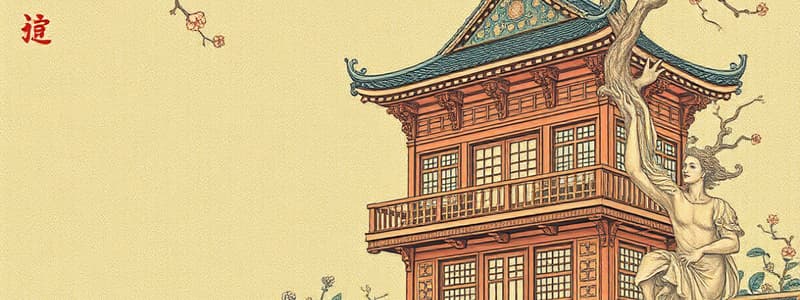Podcast
Questions and Answers
What does the term 'gojūon' refer to in the context of the Japanese language?
What does the term 'gojūon' refer to in the context of the Japanese language?
- A type of polite speech
- A complicated writing system
- A specific character set
- A table of 50 sounds (correct)
Which of the following elements does not belong to the group of modified Hiragana forms?
Which of the following elements does not belong to the group of modified Hiragana forms?
- Romaji (correct)
- Handakuon
- Yōon
- Dakuon
How many basic Hiragana letters are there in modern Japanese?
How many basic Hiragana letters are there in modern Japanese?
- 54
- 50
- 40
- 46 (correct)
Which letter is used exclusively as a particle in a sentence?
Which letter is used exclusively as a particle in a sentence?
What is indicated by the two small dots in Dakuon?
What is indicated by the two small dots in Dakuon?
Which of the following combinations represents a Yōon sound?
Which of the following combinations represents a Yōon sound?
What is the function of Sokuon in the Japanese language?
What is the function of Sokuon in the Japanese language?
Which family is Japanese most widely believed to be connected to?
Which family is Japanese most widely believed to be connected to?
Which of the following describes the role of Hiragana in sentence formation?
Which of the following describes the role of Hiragana in sentence formation?
What were the two syllabic scripts developed from kanji?
What were the two syllabic scripts developed from kanji?
Which of the following is NOT a component of the Japanese writing system?
Which of the following is NOT a component of the Japanese writing system?
From which language does the word 'biru', meaning 'beer', originate?
From which language does the word 'biru', meaning 'beer', originate?
What is the main influence on Japanese vocabulary since the mid-18th century?
What is the main influence on Japanese vocabulary since the mid-18th century?
Which characteristic is NOT true of the sound pattern in the Japanese language?
Which characteristic is NOT true of the sound pattern in the Japanese language?
What is the role of vowel length in the Japanese language?
What is the role of vowel length in the Japanese language?
Which of these words is represented by a loan from Portuguese?
Which of these words is represented by a loan from Portuguese?
What happens to the consonants /s/ and /t/ when they occur with the vowel /i/?
What happens to the consonants /s/ and /t/ when they occur with the vowel /i/?
What is the primary use of Hiragana in the Japanese writing system?
What is the primary use of Hiragana in the Japanese writing system?
How does Katakana differ from Hiragana?
How does Katakana differ from Hiragana?
Which dialects of Japan are noted for being virtually incomprehensible to speakers of other dialects?
Which dialects of Japan are noted for being virtually incomprehensible to speakers of other dialects?
What are the three main politeness levels in spoken Japanese?
What are the three main politeness levels in spoken Japanese?
What determines the formality of speech in Japanese society?
What determines the formality of speech in Japanese society?
What is the primary function of the Kanji script in the Japanese writing system?
What is the primary function of the Kanji script in the Japanese writing system?
What role do onomatopoeias play in the Hiragana writing system?
What role do onomatopoeias play in the Hiragana writing system?
What does the term 'gojūon' refer to in the context of Katakana?
What does the term 'gojūon' refer to in the context of Katakana?
Which letters indicate the voiced sound in dakuon?
Which letters indicate the voiced sound in dakuon?
How many basic Katakana letters are there in total?
How many basic Katakana letters are there in total?
What is the function of small symbols like ャ, ュ, and ョ in Yōon?
What is the function of small symbols like ャ, ュ, and ョ in Yōon?
Which of the following statements about the vowels in Katakana is correct?
Which of the following statements about the vowels in Katakana is correct?
What does the term 'handakuon' refer to?
What does the term 'handakuon' refer to?
Which letter is not typically included in the gojūon categories?
Which letter is not typically included in the gojūon categories?
Which of the following pairs have the same pronunciation in Katakana?
Which of the following pairs have the same pronunciation in Katakana?
Flashcards
Japanese language family
Japanese language family
Likely related to the Ural-Altaic language family, which also includes Turkish, Mongolian, Manchu, and Korean.
Kanji
Kanji
Chinese characters adopted into Japanese writing.
Hiragana and Katakana
Hiragana and Katakana
Two syllabic scripts created from Kanji.
Gairaigo
Gairaigo
Signup and view all the flashcards
Rōmaji
Rōmaji
Signup and view all the flashcards
Japanese vocabulary influence
Japanese vocabulary influence
Signup and view all the flashcards
Japanese open-syllable sound pattern
Japanese open-syllable sound pattern
Signup and view all the flashcards
Japanese Vowels
Japanese Vowels
Signup and view all the flashcards
Japanese Hiragana/Katakana
Japanese Hiragana/Katakana
Signup and view all the flashcards
Hiragana Use
Hiragana Use
Signup and view all the flashcards
Katakana Use
Katakana Use
Signup and view all the flashcards
Japanese Dialects
Japanese Dialects
Signup and view all the flashcards
Social Styles of Speech in Japan
Social Styles of Speech in Japan
Signup and view all the flashcards
Politeness Levels in Japan
Politeness Levels in Japan
Signup and view all the flashcards
Palatalization of /s/ and /t/ with /i/ vowel
Palatalization of /s/ and /t/ with /i/ vowel
Signup and view all the flashcards
/t/ pronunciation with /u/ vowel
/t/ pronunciation with /u/ vowel
Signup and view all the flashcards
Hiragana Letters
Hiragana Letters
Signup and view all the flashcards
Gojūon-zu
Gojūon-zu
Signup and view all the flashcards
Dakuon
Dakuon
Signup and view all the flashcards
Handakuon
Handakuon
Signup and view all the flashcards
Yōon
Yōon
Signup and view all the flashcards
Sokuon
Sokuon
Signup and view all the flashcards
Japanese Polite Speech
Japanese Polite Speech
Signup and view all the flashcards
Additional Hiragana Letters
Additional Hiragana Letters
Signup and view all the flashcards
Katakana
Katakana
Signup and view all the flashcards
Gojūon-zu
Gojūon-zu
Signup and view all the flashcards
Dakuon
Dakuon
Signup and view all the flashcards
Handakuon
Handakuon
Signup and view all the flashcards
Yōon
Yōon
Signup and view all the flashcards
Gojūon
Gojūon
Signup and view all the flashcards
Katakana letters
Katakana letters
Signup and view all the flashcards
Modified Katakana forms
Modified Katakana forms
Signup and view all the flashcards
Study Notes
Introduction to Nihongo
- Nihongo is the Japanese language.
History
- Japanese is believed to be part of the Ural-Altaic family, including Turkish, Mongolian, Manchu and Korean.
- Korean and Japanese share similarities in structure, vowel harmony, lack of conjunctions, and extensive use of honorific speech.
- The adaptation of Chinese characters in the 6th-9th centuries was a key moment in its development.
- Hiragana and katakana were developed from kanji.
- Since the mid-18th century, a large number of English words have been imported into Japanese.
- Words from Portuguese, Dutch, and Spanish have also been incorporated into the language, mainly during the 16th and 17th centuries.
Characteristics
Vocabulary
-
Japanese is written using a combination of three scripts: Chinese characters (kanji), hiragana, and katakana.
-
Rōmaji, the Latin alphabet, is also used in modern Japanese, especially for company names, logos, advertising, and inputting Japanese into computers.
-
Japanese vocabulary has been heavily influenced by words borrowed from and modeled after Chinese over 1,500 years.
-
Substantial borrowing of words from Indo-European languages, primarily English, has occurred since the late 19th Century.
Sound of the Language
- Japanese has an open-syllable structure, meaning most syllables end in a vowel.
- There are five vowels: /a/, /i/, /u/, /e/, and /o/.
- Vowel length often distinguishes words.
- The basic consonants are /k/, /s/, /t/, /n/, /h/, /m/, /y/, /r/, /w/, and the syllabic nasal /N/. Many consonants can be palatalized.
- /s/ and /t/ when combined with /i/, become palatalized /shi/ and /chi/.
- /t/ is pronounced as /ts/ in front of /u/.
Writing System
- Japanese uses two kana scripts (hiragana and katakana), which are phonetic scripts based on simplified Chinese characters.
- Hiragana and Katakana are alternative (but functionally equivalent) versions of the same set of sounds used in the language.
- Hiragana is primarily used for grammatical purposes and often for words with less common kanji, as well as onomatopoeias.
- Katakana is primarily used to show loan words from other languages.
- Hiragana and Katakana each consist of roughly 50 letters.
Varieties
Regional Dialects
- Japan has a large number of dialects.
- Some dialects, particularly in southern Japan (Kyushu and Okinawa), are significantly different.
- The standard dialect, spoken around Tokyo, is required for communication.
- The Kansai region's dialects (Kyoto, Osaka, and Kobe) are another major dialect family.
Social Styles of Speech
- Unlike many Western languages, Japanese uses different grammatical forms to convey politeness and formality.
- Spoken Japanese has three main politeness levels: plain form ("kudaketa"), simple polite form ("teinei"), and advanced polite form ("keigo").
- In Japanese society, a more formal tone is often required depending on the social standing of the people communicating, as equality in status is not always expected.
Hiragana
- Hiragana is one of three Japanese writing systems used to write syllables and sentences.
- It has no individual meaning.
- Hiragana is made from simplified Chinese characters, and was developed during the 8th to 10th centuries.
- Current Japanese uses 46 basic Hiragana letters.
- Modified Hiragana forms exist to represent more complex sounds, which include items like dakuon (voiced sound of a syllable), handakuon (half voiced sound), yoon (combining consonant from one column of the gojūon chart with another), and sokuon which represents a pause between syllables.
- Hiragana's gojūon-zu lists its 50 fundamental sounds within a table.
Katakana
- Katakana is another of Japan's three writing systems.
- It's based on the sounds of syllables and expresses no individual meaning.
- It is made from simplified Chinese characters.
- Katakana and Hiragana use the same set of sounds.
- Katakana is commonly used for loan words of foreign languages.
- Current Japanese uses 46 basic Katakana letters.
- Katakana uses modified letter forms, creating different sounds, with structures similar to Hiragana.
- Katakana's gojūon-zu layout provides the fundamental sounds within a table.
Studying That Suits You
Use AI to generate personalized quizzes and flashcards to suit your learning preferences.





